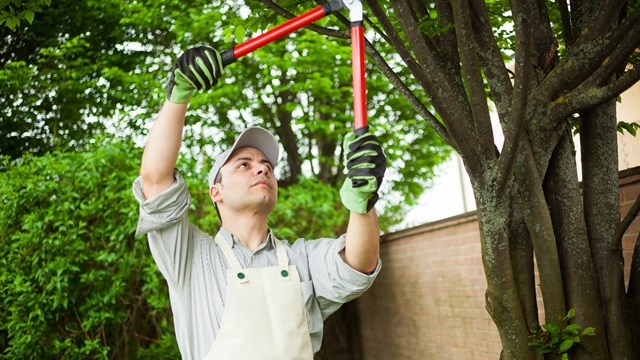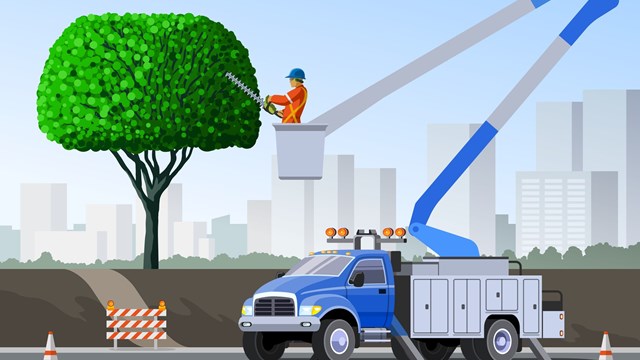March in New England is a month of surprises. Winter throws us last-ditch nor'easters that are followed by spring's sudden thaw. There might be two feet of snow one day, and sunny skies with temperatures in the sixties the next. The only thing that's guaranteed is damage to the landscape caused by ice, snow, sand, salt, and the mighty plow.
About this time of year, associations, owners, and managers must begin to assess the grounds and figure out what must be done to clean up, fix up, and perhaps take some element away and add something new. The big spring landscape cleanup requires professionalsfor both the natural elements and those that are man-made. "Typically, the spring cleanup is included in the RFP [request for proposal] given to landscapers," says Andrew Raynor, president of Shawmut Property Management in North Andover, Massachusetts. This usually includes picking up branches, raking, and sweeping, and it might include tree work.
Step by Step
A good first step is a walk around the complex with a clipboard in hand. "I like to include the association president or a member of the landscaping committee in the walkaround," says Raynor, explaining that these people may have requests that go beyond the contracted work. Make a list of damage you see, noting where it is: broken branches in big trees next to the pool, smashed shrubs alongside garages, torn-up lawn at the edge of the parking area, loose cobblestones on the walkway to building B, and so on. This will help the landscaper or manager prioritize the work.
One of the most visible problems will be damaged trees. This work requires experts, for both human safety and for the protection of this most valuable natural asset. "A licensed arborist is insured to do tree work," explains Stacie Mikol of Distinctive Gardens and Tree Care in South Windsor, Connecticut. "We have the proper equipment, including bucket trucks, and our employees undergo continuous training."
Large fallen branches should be cut up and taken away; and dead and damaged branches remaining on trees should be properly trimmed to ensure the health of the tree. If a tree is split or loses a significant number of branches, a tree expert will be able to advise you whether or not the tree should be cut down.
New properties with newly planted trees are not exempt from maintenance. "Trees of all ages need to be taken care of," says Mikol. "Even younger trees need care." In fact, it is very important that trees are carefully pruned at an early stage to ensure they grow properly. Trees with crossing limbs and woundedtrees all need work, no matter their age. Mulch rings are often added around the base of trees to protect them from lawn mowers, which can damage trunks. "Mulch should not be raised like a volcano," Mikol adds.
Mikol points out that it is crucial that trees are planted correctly. "Sometimes builders will backfill on trees, and if a tree has too much soil on its roots it will eventually die," she says. If young trees don't look healthy, they may need to be dug up. "Trees can be removed and the soil amended by adding nutrients, then the trees are replanted," she explains. A licensed arborist will know if replanting is necessary and when to do the work. "When I talk with property managers, I encourage them to be proactive rather than reactive. It is much more cost-effective to do this."
If a tree has grown too large for its location and is now dangerously hanging over a structure or if its roots threaten to penetrate the basement walls, it may be time to remove it. As you look at each tree, consider whether or not it has room to grow, and if it is full-grown, decide if it will pose a safety hazard as it slowly declines in the years ahead. Many trees will live a hundred or more years, but many others have a much shorter life span. A tree expert will know where yours stand.
"For any tree that is close to dumpsters, a streetlight, or a roadway, we might do crown raising," Mikol says. This is when the lower branches are cut so that they don't hang down on passing pedestrians or cars. "Only a certain percentage of the foliage can be cut without harming the tree," explains Mikol.
Next in line for evaluation are shrubs. Snow falling off roofs often crushes shrubbery, and sometimes ice snaps branches. Raynor notes that protection of shrubs should begin in the fall, when, for example, rose bushes can be covered. "You must make sure you get ready for winter, to mitigate the damage," he notes. In spring, shrubs should be pruned to shape and rejuvenate them, and dead wood should be removed. Shrubs that are too leggy, meaning the leaf growth is mostly on the tips of branches and undersides are mostly woody, require major cutting, with perhaps one-third of the branches taken out. Spring is also the time to spread mulch around shrubs. This will help keep down weeds, keep moisture in the soil, and keep those invading mowers away. Mulch rings around trees and shrubs also help reduce lawnmaintenance costs by eliminating the need for trimming the edges of lawns with weed-whackers or hand shears.
Paved Areas Need Care, Too
One of the most depressing pieces of the early spring landscape is the sand, salt, and mud that seems to cover every paved surface. Fortunately, this is also one of the easiest problems to fix. Walkways should be swept clean. Take care to pick up the sand and salt rather than sweeping it into the lawn or garden beds, where it can kill plants and grass. Driveways and parking areas may require the help of street sweepers that vacuum up winter's debris. Ask your landscaper if he or she has this equipment, and if they don't, make surethey will pick up the sand and salt.
After paved areas are cleaned, it's time to evaluate them. Look for loose or broken cobblestones, bricks, and stones. Check edging for breaks, and consider the condition of all asphalt. Potholes should be quickly repaired to avoid further crumbling. You may need a mason to fix walls and walkways, and don't forget to check chimneys for ice damage.
Lawns make up a large percentage of the greenery around many condominiums, so it is important to keep them looking their best. After winter, fallen sticks and branches should be picked up and leaves raked. Areas where plows have torn up the turf should be repaired and reseeded. Lawn care experts may recommend fertilizer and/or grub-control pesticides, but you should consider organic products that are safe for animals and children, especially in areas where people may sit and play.
As water conservation becomes a bigger issue, you might consider reducing the amount of lawn that needs watering by replacing it with less water-dependent plants or shrubs. "Spring cleanup includes an evaluationof sprinkler systems to make sure the heads are all functioning and there are no leaks in the line," Raynor says. "If there are leaks, you will lose an incredible amount of water."
Year-Round Curb Appeal
Whether it comes in March or waits until April in your area, spring is also a time of great beauty, and if you planahead and act immediately, your condominium complex can have a lot of curb appeal as soon as the real estate market warms up with the weather. "Landscaping is critical," says Raynor. "The associations that look the best from the curb often do sell better."
What could be more eye-catching than a row of flowering dogwoods or a path lined with daffodils or cold-hardy pansies? You will need to plant daffodil bulbs in the fall to get a spring bloom, but now is the time to consider where those daffodils should go. Look for that dreary spot where the snow melts first, the spot you see first upon entering the driveway, or perhaps the place that catches your eye as you drive by. These are good places for a splash of spring color. Try planting pansies now, and bury daffodil bulbs in the same places come fall. Tulips are another fall bulb option, but voles may eat the tulip bulbs while leaving the daffodil bulbs alone.
One trend that Raynor applauds is the increase in the number of community gardens. Homeowners are given designated areas in which they can plant and tend gardens. These might be vegetables, flowers, or even small groupings of trees. These areas are often quite beautiful, Raynor explains, adding that they are a "benefit to the entire community."
Paula Consolo is a freelance writer and editor who lives in Ashfield, Massachusetts.







Leave a Comment